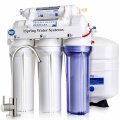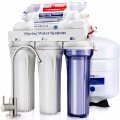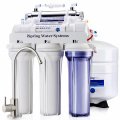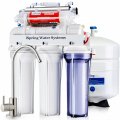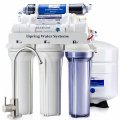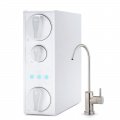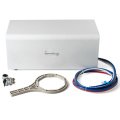Reverse Osmosis
Reverse Osmosis Water System
A reverse osmosis water system gives you filtered and great-tasting water straight from your tap. In fact, this same filtration technology is used by bottling companies to filter their water. Order your reverse osmosis water filter today and get free shipping with iSpring Water Systems!

Why Use Reverse Osmosis Water Filters and Are They Worth It?
Tap water is convenient to drink and use but contains harmful chemicals, sediment and minerals that impact the taste and cleanliness. Bottled water may give you palatable drinking water, but using it for cooking and cleaning is expensive, and the extra plastic is detrimental to the environment. Reverse osmosis (RO) water filters are worth it because they provide you with clean drinking, cooking and washing water with zero plastics.
iSpring Reverse Osmosis Systems
iSpring offers multiple RO water filtration systems for homes and businesses. Our models are easy to install, and most systems fit neatly under the sink, delivering pleasantly clean water straight to the faucet. Some of our products are NSF certified, ensuring high quality and safety standards.
How Our RO Systems Deliver Clean Drinking Water to Your Home
iSpring’s reverse osmosis systems leverage various filters to provide water on par with the bottled varieties at the store:
- Pre-filter stage: When water enters your system, it runs through three pre-filters. This initial filtration eliminates significant contaminants, protecting the RO layer from elements like dirt, sand, chlorine and chloramines.
- Reverse osmosis filter stage: The water molecules run through the reverse osmosis membrane, which removes contaminants down to 0.0001 microns. This cost-effective process rapidly removes up to 99% of 1,000-plus harmful water contaminants such as vinyl chloride, chlorine, fluoride, lead, arsenic, asbestos, calcium, sodium and more.
- Post-filter stage: The RO system presses the water through a post-carbon filter. The fine granular activated carbon filter gives your water a final polish, delivering delicious water instantly to your faucet.

We provide add-ons like ultraviolet (UV) and alkaline filters should you want to refine your filtration system further.
Benefits of Our RO Water Filter Systems
iSpring Water Systems has specialized in creating efficient, clean water solutions for business owners and homeowners in the United States for almost 20 years. We provide:
- Excellent return on investment: Our RO filters range from $200 to $600, depending on size and application. The average American uses 82 gallons or over 310 liters of water daily. One gallon or 3.7 liters of this amount is used for drinking. The average 500ml bottle of water costs $1.50. You will see a return on investment in drinking water alone within months.
- Environmentally friendly alternatives: By investing in our reverse osmosis systems, you get clean drinking water without introducing new plastics to the environment. You will also reduce your carbon footprint by eliminating the logistical elements of bottled water.
- Lifetime technical support: We aim for 100% customer satisfaction. Our reverse osmosis systems are easy to install, but our team is on standby if you need technical support.
Get Clean and Delicious Water Straight From Your Tap With RO Water Filters
A reverse osmosis water filter system will help remove contaminants from your water, providing you delicious-tasting and clean drinking water at home. iSpring has two decades of experience offering customers quality RO systems and exceptional customer service. Shop for your RO water filter system today online and get free shipping! Alternatively, call our team at 678-261-7611 for more information.

